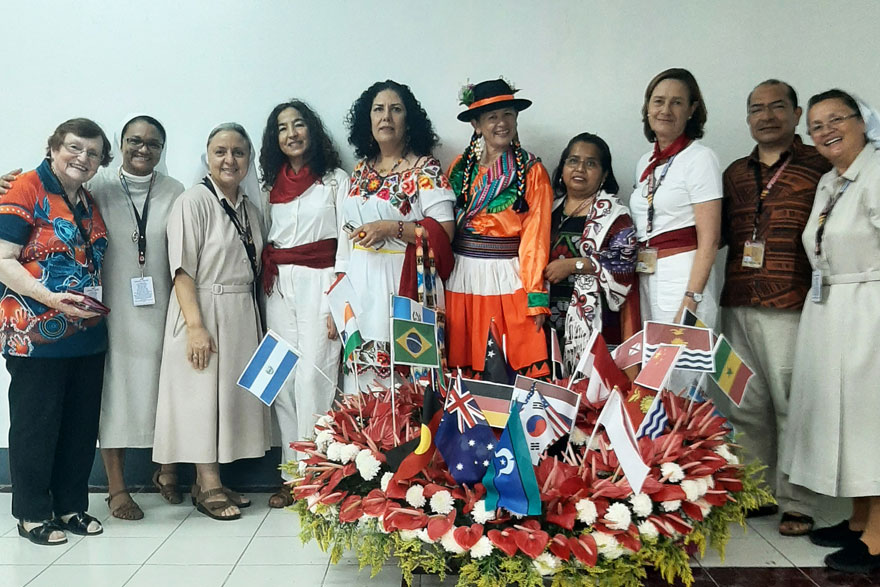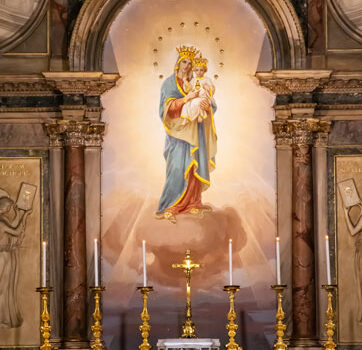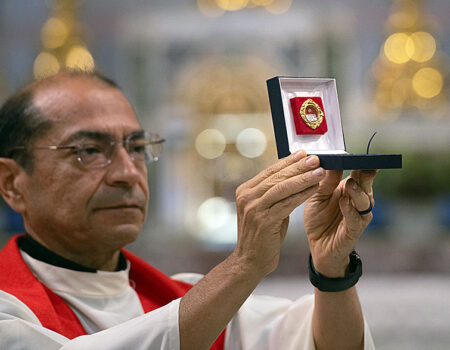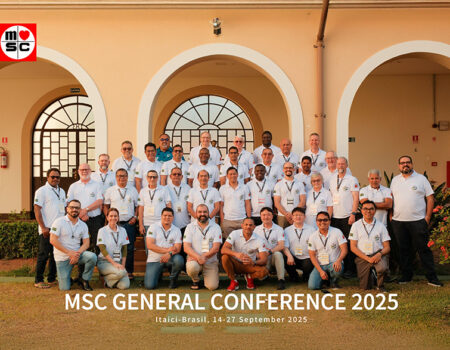Chevalier family: Farewell to active Religious Life in the Western world and looking forward to a new future
Saturday December 28, 2024

I am writing this article for three reasons. First, active Religious Life in the Western world suffers from widespread ageing and a meagre number of vocations from Western countries. Even some or all of the three Congregations of the Chevalier Family (MSC, FDNSC, and MSC Sisters) will most probably die out in Europe, Australia, North America, and Canada or will depend on foreign missionaries in the future. What can we, who are directly involved in this process, expect from the future?
The second reason is that this process of phasing out of religious congregations in the Western world goes along with a growing number of lay people associated with these Congregations. For us, that growth concerns an increasing number of Chevalier Associates. What can we expect from them?
In answer to that question, I describe very briefly the spirituality that Father Chevalier bequeathed to not only religious but also lay members of the Chevalier Family: a Spirituality of the Heart. Chevalier spoke of ‘Devotion to the Sacred Heart,’ but to do justice to his vision, it is today better to speak of a Spirituality of the Heart. This spirituality can be meaningful to many people who are seeking meaning in life.
The third reason is of a very different kind. Our brothers and sisters in non-Western countries often look with astonishment at the process, which in the religious domain is taking place in the Western world and also affects their mother provinces. Perhaps this brief reflection will help them somewhat.
(In this article, I rely in part on the collection of essays in “Religieus Leven met Toekomst” (Religious Living with a Future,) edited by Arnold Smeets and Henk Witte (Berne Media, Heeswijk 2022). The page numbers behind the quotes refer to this book).
The decreasing number of Religious in Active Congregations in the Western world.
It began in the 1960s. In the Western world, in both male and female active congregations, fewer and fewer candidates were entering, and many members were leaving. The decreasing number of entries and the increasing number of members leaving the Congregations were related to a cultural change that took place in the 1960s and 1970s in the Western world. This cultural change affected social life, church, and religious life. The rebuilding of society after wartime led to increasing prosperity in the Western world. More and more opportunities opened for girls and boys to pursue higher education and choose from several professions. This went together with a growing desire for autonomy and personal freedom. People demanded the right to participate in decision-making in various areas and requested recognition of their human rights. The possibility of birth control led to families of two or three children, Catholic families not excepted. Even Pope Paul VI’s Encyclical ‘Humanae Vitae’, which banned artificial birth control, did not change this.

The Second Vatican Council (1962-1965) also created a new atmosphere in the Church. What had previously been almost unthinkable, namely the withdrawal of religious after perpetual vows or ordination, was after the Council considered a free, personal choice. The celibacy obligation for priests and the observance of the vow of being unmarried were valued differently, not only among religious and priests but also among Catholics in general.
The Council emphasised the shared responsibility and social commitment of all the faithful as people of God, priests, religious people, and laity. It also stressed the importance of the personal decision of conscience in moral life. And, as Stefan Mangnus o.p. and Henk Witte write, fathers, sisters, and brothers began “to look differently at community life. In our regions, all this took place in a climate of individualisation. Many were breaking away from the dominant regime of the collective. People had to learn to live and work with each other as individuals with their own character. This was not easy and often led to a choice of a different state of life” (p. 34).
We can conclude that neither the decreasing number of candidates nor the increasing number of exits was due to a decline in religious life itself or to unfaithfulness to vows of the religious, who left. The most profound reason may be found in a cultural shift in society since the 1960s and 1970s in the Western world and, related to that, a new vision of Church and Religious Life, as endorsed by the Second Vatican Council.
The process that is still taking place today in many areas of society and the Church and in the life of Western congregations shows that, as the Second Vatican Council writes, humanity is entering a new era in its history, in which profound changes are taking place (Gaudium et Spes n.4). Pope Francis once put it this way: we live not only in a time of change but in a change of time.
Change of times and new missionary communities.
In his article ‘Religious Life: a Tradition with Resilience’ (pp. 22-30), Peter Nissen describes how monastics had always read the signs of the times and how, when times and culture changed, they ‘always understood the art of responding to new needs and new challenges in church and society’ (p.24). If new social developments occurred, they would respond to the demands made on them by Church and society. Peter Nissen speaks of ‘the resilience’ of the Religious and points out that the ability of the Religious to respond to social and ecclesiastical challenges is a valuable element that must be maintained for the future (p.25).
With Pope Francis, we may say that the Holy Spirit in every time and place generates ‘forms of practical wisdom’. (Evangelii Gaudium n. 254). The question is, which ecclesial and social developments in the Western world now challenge active congregations to take new paths which may be considered the fruit of the work of the Holy Spirit? Inspired by the Holy Spirit, the Second Vatican Council proclaimed a new vision of the Church. The Church is not primarily a hierarchical organisation with Pope, bishops and priests as CEOs and the Catholic people as clients, but a community called together by God’s Spirit from all nations, which intends to be a visible sign of solidarity, peace, justice and respect for creation. All baptised persons are called to participate in this mission of the People of God in church and society.
For us, that growth (lay people) concerns an increasing number of Chevalier Associates.
Further developing the Council’s renewed vision of the Church as People of God and its missionary vocation, the Synod on the Synodality of the Church (2021-2024) placed particular emphasis on the missionary role of the laity in the Church. The Final Document of the Synod writes: ‘’Journeying together as disciples of Jesus, in different places, with the diversity of charisms and ministries, is an effective sign of the presence of God’s love and mercy in Christ‘’ (n. 120). In his address at the end of the Synod (26 October 2024), Pope Francis called the fruits of the Synod “a gift of the Holy Spirit.”
Until recently, communities of men and women who had taken vows often lived in large monastic buildings, strictly separated from the laity. The Synod’s final document, however, speaks of new communities and associations of the laity, which “contribute much to the life of local Churches and the vitality of missionary action” (n.90). What makes these communities new and binds them together is no longer the observance of common vows or promises, but a shared spirituality.
Peter Nissen writes that it is “precisely the connection of one’s own tradition of spirituality together with a personal faith experience” that constitutes the strength of missionary communities. “It is a strength, he writes, that is as relevant as can be. For while ecclesial faith is in sharp decline in our part of the world, the need for spirituality does not seem to be disappearing to the same extent and at the same pace. People are, precisely … looking for values, which give orientation to their lives and for practices and models, with which to nurture those values” (p. 29).
In Western society, many people search for meaning in life. The lifestyle and social engagement of newly formed communities that are truly driven by “spirituality together with a personal faith experience” may “with their spiritual offerings be an oasis for the seeking person” (p. 29), while presenting them a clearer perspective and a way forward in life.
Looking forward: following Jesus Christ inspired by a Spirituality of the Heart.
Whereas Chevalier’s congregations in the Western world have few or no members of Western origin left, Spirituality of the Heart, inherited from Chevalier, may still show a path to people searching for meaning in life. That process can happen when communities of Chevalier Associates, together with new international religious communities, continue to promote Chevalier’s spiritual legacy for the benefit of modern society.
The Second Vatican Council called on every religious congregation to return to the original spirituality of their Founder. As early as the 19th century, Chevalier already envisioned a common project of religious men and women, priests and laity together. He considered lay people, who joined what he called “the movement of the heart,” not merely to be objects of pastoral care for the religious and the priests but as being fully engaged Missionaries of the Heart, just like the fathers, brothers and sisters. For him, this participation of lay people was the logical consequence of the social dimension of his perception of the Spirituality of the Heart. Indeed, without the laity, living the Spirituality of the Heart was impossible as a remedy for society’s ills. Past and present, the laity can live a Spirituality of the Heart both at home in their families and through how they practice their professions and participate in public life. Chevalier thus bequeathed the Spirituality of the Heart to a community of religious and laity.
According to the Council, the heart of the mission of every religious community lies in ‘following Jesus Christ, as the Gospel presents it to us.’ (Perfectae Caritatis n. 2). The Gospel encourages us to follow the Son of God, who became human. ‘With human hands He did work, with a human mind He thought, with a human will He acted, with a human heart He loved’ (Gaudium et Spes n. 22). Stefan Mangnus and Henk Witte stress the prophetic significance of following Jesus Christ, as we meet Him in the Gospels. After all, authentically lived Christian faith gives a critical voice to Church and society, “standing up for people who are marginalised in society” (p. 41).
Chevalier considered the devotion to Our Lady of the Sacred Heart primarily as a powerful means of bringing people to live a Spirituality of the Heart.
Spirituality of the Heart led Chevalier to the conviction that if people knew Jesus of the Gospel better – Jesus, who loves with all his heart – they would love and follow him more. In this way, they will repent of indifference and selfishness, and consequently, society will also be cured of these evils. That is why Chevalier urges his followers to read and contemplate the Gospels and to be guided by a passion for Jesus Christ, who repeatedly shows his merciful heart in the Gospels.
In the Heart of Jesus, he proclaims, we meet the revelation of God’s Heart. God’s love is at work in the heart of creation and salvation history, driven forward by Christ’s Heart’s merciful love. Everywhere there is beauty, love and truth, he sees a manifestation of the love of Jesus’ Heart. For him, this is the realisation of God’s plan, ‘to bring all creation together, everything in heaven and on earth, with Christ as Head’ (Eph 1:10).
Chevalier teaches us that God shapes every human heart on the model of the human heart of His Son. The deepest desires of the Heart of Jesus desires for love, peace, justice and wholeness of creation also animate our hearts. They are also God’s desires. Awakening those desires in the hearts of searching people is at the heart of the mission of the Chevalier Family.
With Chevalier, we can see a new world emerging from the Heart of Jesus, pierced at Calvary. John sees the broken and wounded Heart of Christ as a source of blood and water—a symbol of the birth of new life. For Chevalier, this is a sign of hope that God is transforming our broken world into a new world. With him, we can proclaim that the modern world, despite all its disasters and suffering, is on the way to a new earth.
For Chevalier, ‘mission’ is first and foremost ‘a mission of the heart’. We become ‘missionaries of the heart’ when we wholeheartedly accept to be sent by Jesus, whose heart is full of love and compassion. The formation of the heart, according to the model of the Heart of Jesus, is a non-negligible part of living Spirituality of the Heart. People discover meaning in their lives when they learn to listen to the voice of Christ and his Spirit in their own hearts, but also learn to ‘listen to the heartbeat of the times’ and ‘listen to what lives in the hearts of people’ (Peter Nissen p. 29).
Chevalier saw in living Spirituality of the Heart the remedy for the ills of the times, the diseases of society. In particular, he pointed to selfishness and indifference as the evils that make society ill. Apart from structural and social causes, the ills of modern society, such as selfishness and consumerism, discrimination, violence and the staggering inequality between rich and poor, also arise from the human heart.
Pope Francis has the same conviction. He writes: ‘The crisis in which the world currently finds itself cannot be solved by mere technical measures. What is needed is ‘a conversion or change of heart’ (LS 218). Therefore, we need ‘a spirituality that can change hearts’ (Evangelii Gaudium n. 262). Communities, practising Spirituality of the Heart, contribute to healing the ills of modern times. Also in his encyclical ‘Dilexit Nos’ (‘He loves us’), Pope Francis writes: “The world can change, beginning with the heart” (n. 28). He quotes the Second Vatican Council, which wrote that for the common good we must improve the disposition of our hearts (Gaudium et Spes n.82; Dilexit Nos, n. 29).
“‘Mission everywhere in the world’ (‘ubique terrarum’) is another integral element of Chevalier’s charism. The deeper reason why we speak of a mission ‘everywhere’ relates to the fact that people in all walks of life, anywhere in the world, are called to participate in the mission of Jesus Christ, who was sent by the Father to carry out his mission throughout the world. The word ‘everywhere’ must, therefore, be understood not only geographically but also sociologically at all levels of society. Communities of Chevalier Associates and international religious communities are therefore called to be pioneers of ecumenism and interreligious dialogue.
Today, cultivating contacts through the Internet might also create a missionary ‘network’ of relationships and thus promote the practical living of a Spirituality of the Heart all over the world. From their own experience of using the internet, Abbot Bernardus Peeters o.c.s.o and Jan Willem Wits write that the digital world opens the door ‘to reach, captivate and bind old and new audiences’ (p.139).
Chevalier considered the devotion to Our Lady of the Sacred Heart primarily as a powerful means of bringing people to live a Spirituality of the Heart. The practice and promotion of a Spirituality of the Heart was the primary goal of Chevalier’s life and ministry. With the same intention today, the devotion to Our Lady of the Sacred Heart might be lived and promoted.
A historical process guided by the Holy Spirit.
The title of this article is ‘’Farewell to Active Religious Life in the Western World.” It will be a farewell to active congregations in their current Western form. But it will be a farewell like parents, who die, say farewell to their children, who will live on. Apart from a possible material heritage, parents leave a spiritual legacy above all. In their way of responding to the challenges of a different time, children will try to integrate core elements of this spiritual legacy into their lives. This is a historical process that repeats itself repeatedly and moves history forward. Thus, as mother provinces, the western congregations of MSC, FDNSC and MSC sisters say farewell to their children, the young provinces and unions in non-western countries. They have formed and guided them for many years, and may now look at the fruits of their missionary efforts in gratitude. In some Western countries, they may even greet missionaries from these young provinces. It is a historical process of progress guided by the Holy Spirit.
The challenge that religious congregations in the West now face, namely to say farewell to traditional forms of religious life while moving forward to new forms of missionary life, also constitutes a historical process. It is a process that has been repeated in history over and over again and is necessary to create space for new forms of missionary presence. Fortunately, in our Chevalier Family, we can expect communities of Chevalier Associates, together with the newly formed International religious communities, to continue to live and put into practice the spiritual legacy of Chevalier. The Holy Spirit is also at work in this process. And, as Fr Piperon MSC, a friend of Fr Chevalier, reminds us: “If a religious family does not want to perish, it must lovingly preserve the spirit it received from the founder.”
Hans Kwakman, MSC





